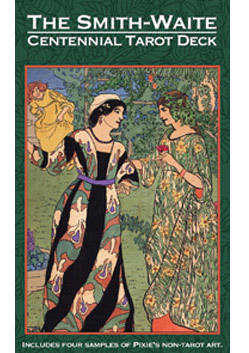Smith Waite Centennial Deck
This faithful reproduction of the original Rider-Waite Tarot deck -- illustrated by Pamela Colman Smith in 1909 -- features the traditional Rider-Waite artwork in the original colors chosen by Smith. Learn More
 Smith Waite Centennial deck © U.S. Games Systems, Inc.
Smith Waite Centennial deck © U.S. Games Systems, Inc.
View All Cards in the
Smith Waite Centennial Tarot Deck
Major Arcana

The Fool

The Magician

The High Priestess

The Empress

The Emperor

The Hierophant

The Lovers

The Chariot

Strength

The Hermit

Wheel of Fortune

Justice

The Hanged Man

Death

Temperance

The Devil

The Tower

The Star

The Moon

The Sun

Judgement

The World
The Wands

Ace of Wands

Two of Wands

Three of Wands

Four of Wands

Five of Wands

Six of Wands

Seven of Wands

Eight of Wands

Nine of Wands

Ten of Wands

Page of Wands

Knight of Wands

Queen of Wands

King of Wands
The Cups

Ace of Cups

Two of Cups

Three of Cups

Four of Cups

Five of Cups

Six of Cups

Seven of Cups

Eight of Cups

Nine of Cups

Ten of Cups

Page of Cups

Knight of Cups

Queen of Cups

King of Cups
The Swords

Ace of Swords

Two of Swords

Three of Swords

Four of Swords

Five of Swords

Six of Swords

Seven of Swords

Eight of Swords

Nine of Swords

Ten of Swords

Page of Swords

Knight of Swords

Queen of Swords

King of Swords
The Coins

Ace of Coins

Two of Coins

Three of Coins

Four of Coins

Five of Coins

Six of Coins

Seven of Coins

Eight of Coins

Nine of Coins

Ten of Coins

Page of Coins

Knight of Coins

Queen of Coins

King of Coins
About the Smith Waite Centennial Deck
Dr. Arthur Edward Waite (1857-1942) was a genuine scholar of occultism whose published works include The Holy Kabbalah and The Key to the Tarot first issued in England in 1910. Waite utilized symbolism as the key to the Tarot pack. In The Key to the Tarot he writes: “The true Tarot is symbolism; it speaks no other language and offers no other signs.” What are the Tarot cards about which Waite so skillfully writes? What is the message of each card and when and where did these fascinating cardboard symbols first originate?
Mercury, said to be one of the early Kings and the inventor of the hieroglyphic system. Gebelin asserts that it is from the Egyptians and Gypsies that Tarot cards were dispersed throughout Europe. The emergence of Tarot cards in Europe predates by over five centuries the work of Waite. A German monk, Johannes, describes a game called Ludas Cartarum played in the year 1377. Covelluzzo, a fifteenth-century chronicler, relates the introduction into Viterbo of the game of cards in the year 1379. It is generally accepted that playing cards emerged in Europe in the latter half of the fourteenth century, probably first in Italy as a complete 78-card deck. Or perhaps some inventive genius subsequently combined the common 56 cards known as the Minor Arcana with the 22 esoteric and emblematic Tarot cards known as the Major Arcana to form the 78-card pack.
Today, Tarot fortune-telling readings generally take into account not only the individual divinatory meaning of a card but also the proximity between two or more cards and whether the card is upright or reversed (which weakens, delays and even reverses the meaning). The brief descriptive title on each of the 22 Major Arcana cards serves as a catalyst toward a broader and deeper meaning, which the diviner seeks to express.
The 56 Lesser Arcana cards contain four suits including the usual court cards; King, Queen, Jack (Valet, Page) plus a fourth card, the Cavalier (Knight, Knave), which is placed between the Queen and the Jack. The suits are generally Swords (Spades), Batons or Wands (Clubs), Cups (Hearts), and Coins or Pentacles (Diamonds). Suit origins are believed to represent the four estates of life during medieval times: nobility or persons who held their rank by military service were symbolized by swords; peasants or working-class people by clubs; clergymen and statesmen by cups; and tradesmen and the industrial class by coins.
Today’s ordinary decks of playing cards seemingly descend from the medieval Tarot decks. As card playing increased in popularity, the Major Arcana cards were dropped (except for The Fool which was retained as the Joker) and the Cavalier and Page were combined into today’s Jack, thus giving us the standard deck of 52 cards plus Joker.
One of the fascinating aspects about Tarot cards is their personal affect upon the individual who uses them. Waite successfully presents a new dimension to their meaning in The Key to the Tarot. Any Tarot reader, be they a serious scholar or a person dabbling in the occult, will benefit from Waite’s insight and keen perception.